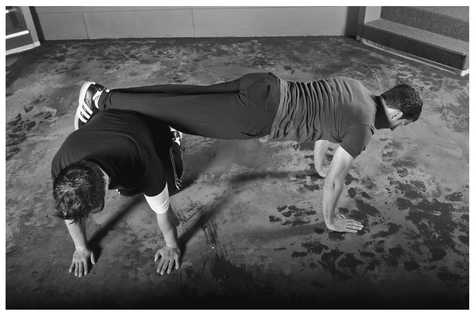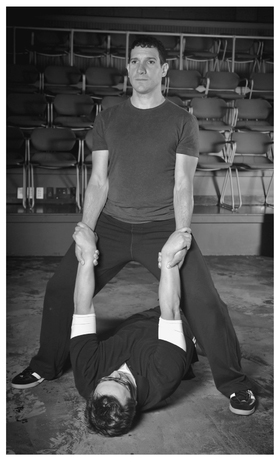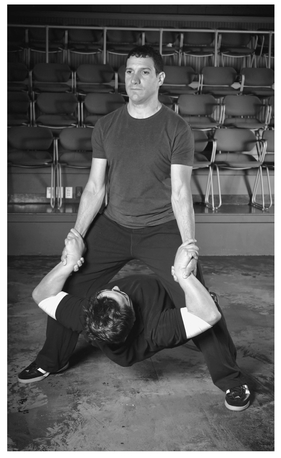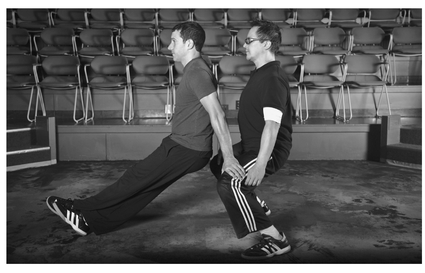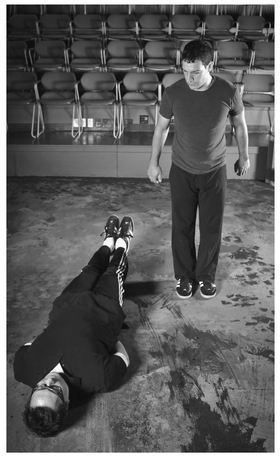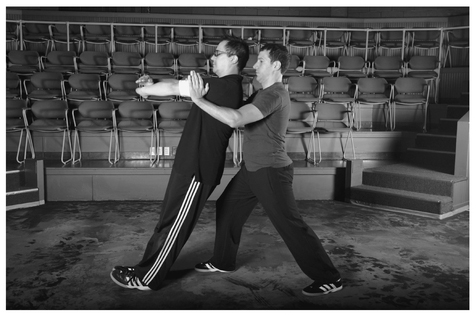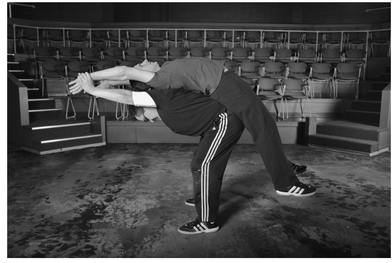Chapter 8
Partnered Conditioning
After warming up, a good regimen of strength conditioning can be useful to improve muscle tone and further develop coordination. If alone, a performer can do a series of solitary exercises such as push-ups, planks, burpees (squat-thrusts,) and sit-ups. However, theatre is a collaborative art and is at its best when people come together to be in the same space at the same time. To further cultivate the collaborative spirit of the performing artist, the following are a series of partnered strengthening exercises that should be done with a partner. Most of these exercises I learned originally from Kyle Rowling, a fight director and head of the Sydney Stage Combat School in Sydney, Australia. Over the years I have discovered some other partnered exercises as well, which has lengthened the list. I find opportunities to perform these partnered exercises with a fellow artist or scene partner whenever I can so I can better gauge my physical responses to external energy. The more opportunities performers have to partner with each other, no matter what the exercise, the more deftly they will be able to respond to each other's energy when engaged in training, rehearsal, or performance. What follows is a comprehensive offering of strength conditioning exercises to be done with your partner. A light workout for this sequence would be 10 repetitions of each move. A more vigorous workout would entail 30 repetitions. These repetitions may be performed at a quick pace with high reps or a slow pace with low reps. When one partner finishes a set, the partners should switch roles. Even though one partner will be performing the reps at a time the other partner should be working on proper positioning and alignment. Whatever the exercise, make sure to be in verbal communication with your partner so that the resistance given or the position supported is appropriate for you to perform the exercise to the best of your ability.
The Iron Cross
Stand in front of your partner facing away from him or her. One partner places his or her hands on the wrists of the partner facing away. Make certain not to grab the wrists. Simply place the open palms on top of the wrists. The partner facing away will raise the arms up from the sides so that both arms stretch out sideways until they are parallel to the floor. While this movement is being executed, the partner standing behind provides resistance. Once the arms are level with the shoulders and parallel to the floor the position can be relaxed and the arms can return to the original position at the sides. The muscles of the shoulder are worked during this exercise (Figures 8.1-8.2).
Decline Push-Ups
One partner gets on all fours (hands and knees table-top position) with a flat back. The other partner places his or her shins on either the hips or the upper back of the partner on all fours. Make certain not to throw the shins on to the lower back of the first partner since the lumbar region is unsupported in this position. The second partner then assumes a push-up position with a flat back and the eyes gazing towards the floor so that the entire spine is in alignment. In this position do as many push-ups as desired. This exercise targets the pectoral muscles (Figure 8.3).
Push-Downs
One partner assumes a sit-up position with the knees bent. The other partner kneels at the feet of the first partner puts the feet of the first partner between the knees of the second partner. As the first partner executes a sit-up and reaches the apex of the position, the second partner pushes the first partner back down to the floor by placing the hands on the upper pectorals of the first partner and extending the arms. The first partner should engage the abdominals on the way down as well so as not to slam the back into the floor (Figures 8.4-8.5).
Leg Throw-Downs
One partner lies on the floor in the supine position while the other partner stands at the head of the first partner. The feet of the standing partner should straddle the head of the supine partner. The supine partner holds on to the back of the standing partner's legs while raising the legs to meet the hands of the standing partner. The standing partner then throws the legs of the supine partner either forward, to the left, or to the right in a random pattern. The abdominals of the supine partner should remain engaged, the legs should be straight, and the feet should not be allowed to crash into the floor (Figures 8.6-8.7).
Partner Pull-Ups
One partner lies on the floor in the supine position. The other partner stands over the torso of the supine partner facing the head. Both partners grasp each other's forearms. The standing partner should have his or her knees slightly bent and his or her feet should be just underneath the armpits of the supine partner. Also, the standing partner should have his or her shoulders back and head up. Be careful not to round the back so as to maintain a strong position while the supine partner executes a pull-up. The pull-up can be done by lifting the whole body off the ground while balancing on the heels with the legs straight. A variation of this exercise can be done with the legs and hips on the floor while executing the pull-up with only the torso. This exercise targets the biceps and major muscles of the back for the partner performing the pull-ups while the standing partner works on alignment and balance (Figures 8.8-8.9).
Partner Dips
One partner assumes a low squat. The other partner gasps the quadriceps of the squatting partner while extending the legs and balancing on the heels. The partner with the legs extended then bends the arms and executes a dip as far as the range of motion will allow. The squatting partner should remain balanced throughout the exercise. If balance is difficult to maintain, the squatting partner can put his or her back against a wall to aid in the exercise. This exercise works the triceps of the partner performing the dips while also working the legs and balance of the partner squatting (Figures 8.10-8.11).
Jump Splits
One partner lies in the supine position with the legs extended and the hands under the hips. The lower back should be flat on the floor and the legs should be lifted off the ground so as to engage the abdominals. The other partner stands to one side of the supine partner's legs facing in the opposite direction. As the supine partner opens the legs in a wide V-shape, the standing partner jumps in between the now separated legs. As the supine partner closes the legs, the standing partner continues jumping in the same direction to the other side. Timing is important as the jumping partner should take care not to land on the legs of the supine partner. Repeat the action back and forth until the desired number of repetitions is reached. This exercise works core strength, rhythm, and timing for both partners (Figures 8.12-8.14).
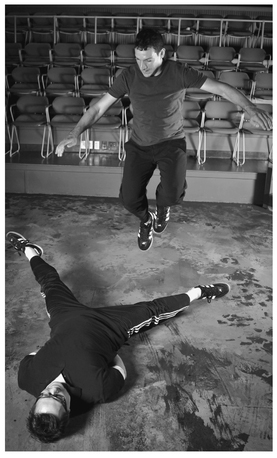
8.13
Back Boards
One partner assumes a lunge position making certain the front knee does not move past the instep of the front foot. The sole of the rear foot is placed completely on the floor. The arms are stretched out straight and in front with the elbows down, palms facing out, fingers pointing to the ceiling. The other partner is in front, his or her back to the lunging partner with the arms parallel to the floor, bent 90 degrees at the elbow, palms facing down. Balancing on the heels, the standing partner leans back slightly keeping the body straight and the core engaged while placing the triceps against the flat palms of the lunging partner. The standing partner now works the muscles of the back (particularly the rhomboids and trapezius muscles) by articulating the arms forward until the tips of the fingers touch. Then articulate the arms to the rear as though the elbows could touch behind the back. All the while the body should remain straight with the hips in line with the shoulders. Be careful not to bend at the waist or round the spine excessively. Also an important point is that the lunging partner should be pushing towards the moving partner with straight outstretched arms. Bending the arms of the lunging partner will often result in a failure in the structure. The skeletal structure of the lunging partner should provide the base for the other partner to perform the exercise. As a result the lunging partner works on alignment and balance (Figures 8.15-8.17).
Table Jumps
One partner gets on all fours (hands and knees table-top position) while the other partner stands to one side with palms placed on the upper back of the first partner near the scapula or shoulder blades. The second partner proceeds to jump over the hips and back to the opposite side of the tabled partner. The feet should leave the floor simultaneously, be raised so as to clear the partner's back as much as possible, and then return to the floor simultaneously as well. If this proves difficult, one may adjust the exercise to jump just clearing the partner's back one foot at a time. This exercise works the abdominal and leg muscles of the partner jumping and develops structural stability for the partner providing the base (Figures 8.18-8.20).
Assisted Handstand Push-Ups
One partner assumes a static handstand position with the second partner grasping the ankles of the first partner. The hand-standing partner should have his or her head, shoulders, hips, and legs as vertical as possible with no bend or sway in the spine. The hand-standing partner bends the elbows until the top of the head touches the floor. Then the hand-standing partner extends the arms until they are straight. If the partner executing the push-ups needs help extending the arms, the partner at the ankles assists by pulling the first partner back to the original position. Take care that the spine (neck or back) of the hand-standing partner does not get out of alignment at any time. Also take care that the hand-standing partner stays in one location and does not begin to "walk" on the hands while performing the exercise. This exercise works the arm and shoulder muscles of both partners while developing alignment awareness and balance for the hand-standing partner (Figures 8.21-8.22).
Table Backstretch
Take care to perform this partnered stretch with two partners of a similar build. One partner gets in the tabletop position while the other partner positions his or her hips to the side of the first partner's oblique muscles, right in the space between the first partner's hips and lower ribs. Keeping the hips to the side of the partner, the second partner bends backwards so that the lower back of the second partner's back is lying across the level lower back of the tabled partner. Once a comfortable position has been attained, the partner on top extends the arms over the head while the lower partner initiates spinal curves in both directions (often referred to as "Cat" and "Cow.") Perform these spinal isolations very slowly so as not to put undue stress on the lower back. This exercise provides not only a wonderful stretch of the back muscles for the top partner but also helps develop core strength for the tabled partner on the bottom (Figures 8.23-8.24).
Standing Backstretch
Another backstretch can be done this time in the standing position. Here both partners begin by facing each other. One partner grasps the wrists of the other partner. The partner whose wrists are being grasped is being stretched. While the wrists of the second partner are being grasped both partners turn in the same direction so that they are both now facing away from each other with their arms over their heads (Figure 8.25). The partner who is doing the grasping then bends his or her legs so that the hips of the other partner are firmly placed in the small of the grasping partner's back (Figure 8.26). Then, the grasping partner bends forward slowly while extending the legs, stretching the arms forward, and lifting the other partner off the floor (Figure 8.28). Be certain to extend the legs here and not bend them further. Bending the legs further will force the muscles to work more to keep the other partner up. This will quickly fatigue the legs. Extending the legs will allow the alignment of the skeletal structure to provide more support for the partner being stretched. If the stretch feels stable, the partners may wish to release the grip and relax even further into the stretch. When the partners wish to conclude the stretch, the bottom partner squeezes the wrists of the top partner and slowly tips back to the standing position. Without letting go both partners turn in the same direction so that they end in the same position they started in. It is important to end in this way in order to protect the lower back. This exercise stretches the muscles surrounding the spine, develops balance, and increases sensitivity to weight sharing for both partners.

8.27
These exercises are meant to help with good muscular maintenance for the major muscle groups most used in executing techniques. They also should begin to develop the physical partnering skills of each individual. After a while, each partner will begin to make physical adjustments naturally in relation to the other. Of course, there is no substitution for verbal communication. When in doubt, always talk to your partner.



